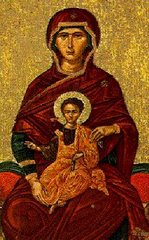Revelation: this is to reveal or make clear something that is hidden from view or not obvious. When we are talking about Divine Revelation, it is God and His Will that are “hidden” from us.
God has revealed Himself to humanity in a number of ways. However, there are two types that stand as the Pillars of Divine Revelation:
1
. Magisterium: the Teaching Authority of the Church, also called Tradition. This is the authority given by Christ to his Apostles, and then passed on to their successors, the bishops. The bishops are guided by the Holy Spirit in their actions and decisions.
2.
Sacred Scripture: The combination of the Hebrew Bible (which we call the Old Testament) and the Christian Scriptures (the New Testament). The Bible is actually a library of books: there are 46 in the Old Testament & 27 in the New Testament. They cover many different literary genres: history, poetry, letters, and wisdom.
The Development of Sacred Scripture:The Christian Faith sees itself as the fulfillment of the Salvation God began with the Hebrews. As such, the Church adopted the Hebrew Bible in its entirety as its “Old Testament”. (Note that a Protestant Bible has seven fewer books in its Old Testament based on different original manuscripts.)
The New Testament, however, was “built from scratch”. The following Five Stages apply generally to the New Testament writings.
1. Event or Objective Reality: An event happens or an objective reality is observed. (Ex. Jesus walks on water; Paul hears of abuses at the Church at Corinth, etc.)
2. Oral Tradition: The message regarding the reality is passed on by word of mouth from one generation to another. Though in our modern literate society we do not trust word of mouth as credible, this was not the case in the ancient world, which was far more accustomed to relying on the spoken word to transmit information. (Note: most of Paul’s letters were written by him or dictated to a scribe, and therefore do not have an “oral tradition” to speak of.)
3. Writing: the oral tradition is committed to writing. Early Christians did not see the need to record their oral tradition. First, they saw the Gospel as intended only for the Jews. They did not anticipate a need to spread the written Gospel beyond Israel. Secondly, the early Christians expected the return of Christ to take place very soon. They did not think it necessary to write down the Gospel for future generations. It soon became clear that the Gospel was indeed a universal message, intended for all people, and that the Gospel was timeless, intended for all generations.
4. Editing: since the Gospels and other texts were handwritten and copied by hand, there were inevitable errors that crept in. None of these errors altered the meaning of the text in any substantial way, but they did result in minor changes from one ancient text to another.
5. Canon: The word canon means “list”, and in this case it refers to a list of Divinely Inspired books. There were many writings that were called “gospels”, but only four that were considered by the Magisterium to be canonical. They had to meet some general criteria:
A. First there needed to be an established
authenticity. This is to say that the Gospel traces its existence back to the apostolic communities where they originated.
B. Secondly, the Gospels need a certain degree of
consistency. If a gospel differs widely from other accounts of the same passage, then their canonical status was questionable.
C. Finally, if a writing was not
universally used by all churches, then its inspiration was held in doubt.
The first known official efforts to create a Canon of Scripture were by synods (meetings of bishops) in Rome in 382 and in Hippo (Northern Africa) in 393, nearly 400 years after Christ’s death.
It should be noted then, that between Scripture & Tradition, it was Tradition that came first and helped in the development of Scripture.
Until next time,
Ad Jesum Per MariamMr. B.
 In creating Venn Diagrams to compare Sacred Scripture with a Newspaper one of the key observations was that both of these collections of documents are made up of different sections, and that interpreting each section accurately requires considering the context.
In creating Venn Diagrams to compare Sacred Scripture with a Newspaper one of the key observations was that both of these collections of documents are made up of different sections, and that interpreting each section accurately requires considering the context.

